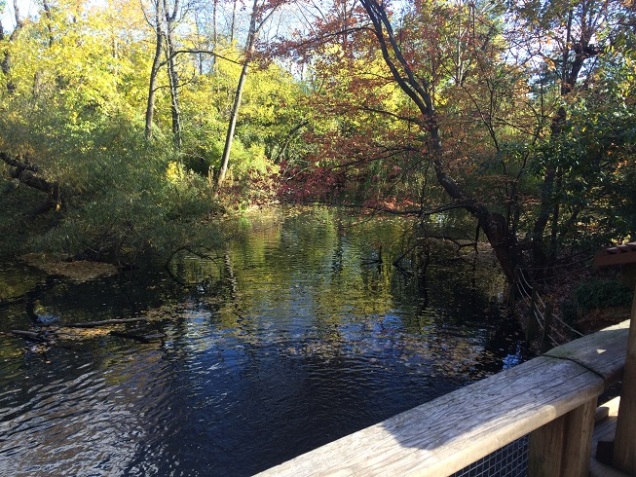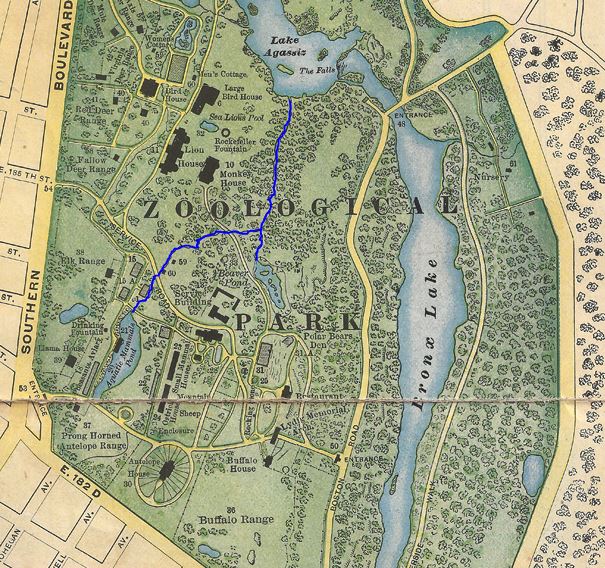When the Bronx Zoo was developed at the turn of the 20th century, its design was considered innovative as it preserved much of its natural terrain, giving many of the animals room to roam at a time when many zoos kept their exhibits in tight cages. The preservation of the landscape enabled the Bronx River to flow freely through the zoo, and retained some of the ponds and brooks within the zoo for the enjoyment of the animals.

Among these waterways are the Northern Ponds and the brook that sends the water downstream from these ponds into the Bronx River.
Where it is

Looking at the 1904 New York Central brochure depicting the zoo, the unnamed brook flows from two sources: Beaver Pond and Aquatic Mammals Pond, flowing north towards Lake Agassiz on the Bronx River. The zoo opened its doors in 1899, part of the larger Bronx Park that was given by the city as a concession to the New York Zoological Society, forerunner of the Wildlife Conservation Society that operates the zoo.
Like Central Park and Forest Park, Bronx Park is located in the center of its borough and has an Olmstedian landscape of forests, ponds and trails that follow the topography. Bronx Zoo preserved the landscape and adapted its natural features for animal exhibits. Fittingly the ponds along this brook serve as habitats for select animals.
Duck Season

Northern Ponds is comprised of two ponds from which the brook originates. I am not certain how much of its water is naturally sourced and how much comes from the city’s water supply, but its location predates the zoo. When the zoo opened, this section of the brook was known as beaver pond, home to New York’s state mascot, which is also the mascot of CCNY, my alma mater.
Today, beavers can be found in the Bronx River, the result of a decades-long cleanup effort. The ponds contain a set of waterfowl: ruddy duck, canvasback, hooded merganser, lesser scaup, wood duck, and the common golden-eye.

Flowing out of Northern Ponds, the brook flows alongside trails in a natural state. It merges with a tributary flowing out of the what was originally called Aquatic Mammals Pond. Today that pond is the Wildfowl Pond, home to the Chilean flamingo, coscroba swan, and Canada goose. On one side of the pond is a boardwalk overlook and on the opposite side is a pavilion for eating while admiring the birds in this pond.

While the photos above were taken this summer during a visit to the zoo, the following set of photos were taken last winter on an earlier visit.
Tributary Brook

When visiting museums and zoos, the public doesn’t notice the gray areas and empty spaces on their maps.
One may presume that these are undeveloped areas but as a Parks employee, I’ve been to such places. This is where we have offices, store equipment, and other items necessary to the operation of the facility.
There is very little water seen in the tributary but its course is visible as a groove in the terrain.
Pere David’s Deer

The brook widens again into a pond for the whooper swan and Pere David’s Deer exhibit, where one can also find visiting mallards and Canada geese. This rare deer (elepharus davidianus) species is native to northern China, but became extinct in its habitat by the early 20th century. A small herd taken to Europe for the Duke of Bedford ensured the survival of this animal. The Bronx Zoo has kept its own herd since 1946, producing 165 offspring as of 2017. They were reintroduced in China in 1985, where they are known as the milu.

Where this pond narrows into the brook is a rustic shelter with informational signage on the deer. Such shelters and bird blinds give the appearance of being on a hunt or safari, seemingly less visible to the animals.
Towards Bronx River

From the deer enclosure, the brook descends down a slope flowing in a ravine between the World of Birds and Astor Court, and past the American bison pasture before ending at the Bronx River. The city’s other zoos also have their waterways, all of them artificial. Only the Bronx Zoo has natural ponds that are part of the zoo’s plan.
Learn More:
Bronx Zoo also has Cope Lake, which I previously documented.
Prior to 1960, the zoo had its own boathouse that stood on the site of today’s JungleWorld exhibit.
The rich history of the Wildlife Conservation Society and Bronx Zoo is told in great detail at Wild Things: The WCS Archives Blog.
5 thoughts on “Northern Ponds, Bronx”